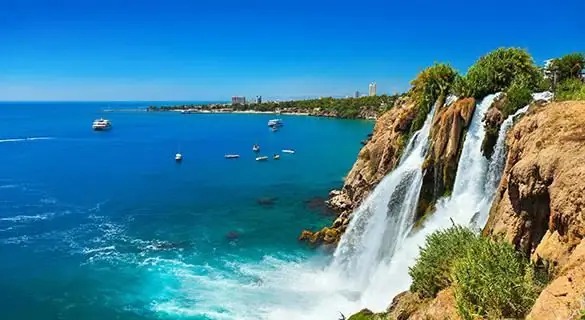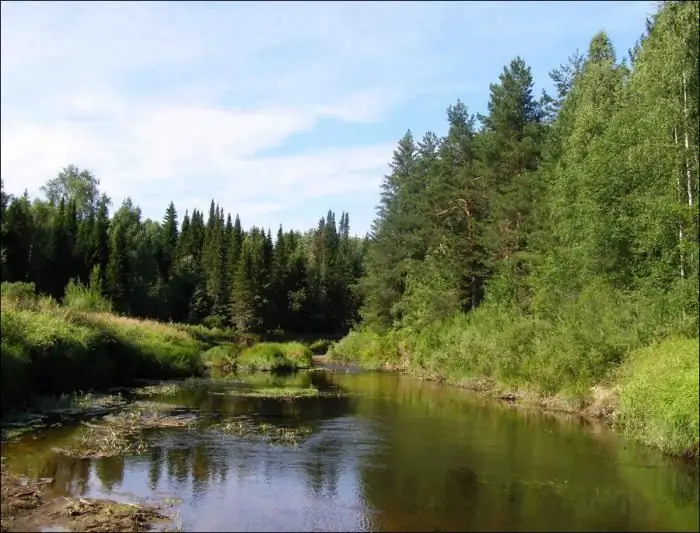- Author Harold Hamphrey [email protected].
- Public 2023-12-17 10:06.
- Last modified 2025-01-24 11:10.
Nizhny Novgorod is a city with almost eight hundred years of history rich in various events. Located at the confluence of the Volga and Oka, it has always been one of the largest cultural, economic and transport centers of Russia. More than once the city served as a stronghold of statehood, defending the country from external enemies. All this contributed to the fact that at present Nizhny Novgorod is rich in interesting memorable places and sights. One of them is the famous old Kremlin.
History
The Nizhny Novgorod Kremlin began to be built around 1500. It was finally completed in 1515. The construction was a two-kilometer wall, which was supported by thirteen towers. One of them, Zachatskaya, has not survived to the present day.

The Nizhny Novgorod Kremlin, which was also called the stone city, had its own permanent garrison, as well as impressive artillery weapons. The Volga fortress was created by the Muscovite state asthe main stronghold, designed to resist the Kazan Khanate. For its military service, the Nizhny Novgorod Kremlin withstood numerous attacks and sieges.
The last page in the combat record of the Volga fortress was written at the beginning of the 17th century. It was a period of foreign intervention and great deeds of the Nizhny Novgorod militia, led by Kuzma Minin and Dmitry Pozharsky.
Description
The Nizhny Novgorod Kremlin is a defensive medieval structure. It is located partially on the flat top of Clock Mountain, as well as on its slopes (from the northwestern part).
The Nizhny Novgorod Kremlin (you can see the photo below) is located on an area of 22.7 hectares. The so-called stone city has a rather impressive size. Its perimeter is 2045 meters. The walls, impregnable in the past for enemies, have a height of twelve to fifteen meters. However, they are also very wide.

The thickness of the walls is from three and a half to four and a half meters. Defensive towers were erected along the perimeter of the stone city. How many towers are in the Nizhny Novgorod Kremlin? At first there were thirteen. Twelve are currently preserved. The names for the towers were chosen according to their use and purpose, or the names of nearby buildings.
The Nizhny Novgorod Kremlin (Nizhny Novgorod) from the day it was founded had cathedrals on its territory, which were the main ones in the city. Among them are Mikhailo-Arkhangelsky, as well as Holy Transfiguration. In "stonecity" there are several parish churches. There are episcopal and grand ducal palaces, as well as several monasteries.
Location of defensive towers
If you look at the plan of the chain of fortifications, you can see that it is an irregular polygon with towers located at the corners. In ancient times they played the role of defensive towers. The scheme of the Nizhny Novgorod Kremlin introduces us to the names of the towers. If you look clockwise, then the first of them is Dmitrievskaya (Dmitrovskaya). This is the main tower. It is named after the great Nizhny Novgorod prince Dmitry Konstantinovich, who ruled in the 14th century.
Next in the pattern is a tower called the Pantry. It was used as a storage space. Nikolskaya Tower was erected next to the now defunct Nikolskaya Posadskaya Church.
The next tower - Koromyslov - is presented to us by a diagram on which the Nizhny Novgorod Kremlin is marked. The history of this building tells of a legendary young woman with a yoke allegedly buried in this place. The fifth tower is Taynitskaya. The tower got its name because of the secret passage located in it leading to the Pochaya River. The northernmost tower is Ilyinskaya.

Not far from it is the Church of Elijah the Prophet. This tower is also called by its geographical location - North. On the Clock Tower in the 16th century. clock has been set.
Ivanovskaya Tower was adjacent to the now destroyed Church of John the Baptist. White was calleda defensive tower because of its white stone cladding, which was laid over the outer facade below. The St. George's Tower was erected not far from the now defunct St. George's Church, and gunpowder and various ammunition were stored in the Powder Tower.
The purpose of the Nizhny Novgorod Kremlin
After Kazan fell, the Volga fortress lost its military significance. In the future, it became the administrative center for a vast district. On its territory there was a command hut. The vicegerent and provincial government was located in the stone city.

Today the Nizhny Novgorod Kremlin is the cultural and administrative center of the city. On its territory there are buildings of the regional and city administrations, as well as the representative office of the President of Russia in the Volga Federal District. Visitors to the former fortification are offered excursions to the Art Museum, as well as to the museum of the Nizhny Novgorod Kremlin. Located on the territory of this ancient stone city and the Center for Contemporary Arts.
Dmitrievskaya Tower
The main defensive tower of the Nizhny Novgorod Kremlin was erected in the central part of the upland area. Its facade overlooks the semicircular part of the square named after Minin and Pozharsky.
Dmitrievskaya tower of the Nizhny Novgorod Kremlin from the moment of its construction played the role of the main entrance to the fortress. It was also the central node of defense of the entire upland area. The leading role of the tower is confirmed by the radial-concentric layout of the city. The fact is that from the very entrance to Dmitrievskayathe tower in different directions, the rays diverge streets. Among them are Ulyanova, Alekseevskaya, Varvarskaya and Bolshaya Pokrovskaya.
The Nizhny Novgorod Kremlin, whose history is contained in ancient chronicles, began its existence with the construction of this particular tower. Documentary sources that have survived to this day confirm this.

In the 17th c. The Dmitrievskaya tower had significant weapons. In its numbers, it surpassed all other defensive towers. Combat equipment existed until 1705. Subsequently, in the late 18th - early 19th centuries. The Dmitrievskaya Tower served as a building for the garrison school. Then it housed the provincial archive, and from 1896 to 1919 - a museum with artistic and historical exhibits. During the period of Soviet power, a workshop producing scenery for ballet, theater and opera worked in the tower for a significant time.
In 1965 a momentous event took place. A gilded coat of arms of the city depicting a walking deer was installed on the roofing spire of the tower.
Storage tower
At the very beginning of the Zelensky Congress is the round tower of the Nizhny Novgorod Kremlin. They call her the pantry. Previously, it was used as a warehouse. In the 17-18 centuries. the tower was called Alekseevskaya, like the church located nearby.
Currently, the tower is a four-tier structure. In its lower part there are underground rooms, in which there are side combat chambers with loopholes. Restoration work carried outin 1953, they made it possible to restore the semicircular extension of the Pantry Tower. This building, erected in the 19th century, is designed to create air ventilation in the pantries of the lower tier, where they stored the garnet oil used to illuminate the streets of the city.

In the second tier of the tower there are similar chambers in the side walls. The third level is a “stone tent” without ceilings. The fourth tier is a walking platform around the tower. Its wall is a battlemented parapet.
Nikolskaya Tower
After the Pantry tower on the scheme of the Nizhny Novgorod Kremlin is Nikolskaya. Its name was taken from the nearby church of St. Nicholas the Wonderworker. In ancient times, this tower played the role of the second most important defense center. In its significance, it was inferior to the Dmitrievskaya tower. At present, with the help of restoration work, the original appearance of the structure with a passing gate has been restored.
During the 17th-19th centuries. the tower was used as a warehouse, significantly changing its internal layout. The restoration work carried out in 1959-62 not only restored the interior rooms. The facade of the tower also took on its original historical appearance. In the same period, the roof of the tower was restored, in the form of a tent with a watchtower.
Yoke tower
In the chain of walls located on the upland area, the corner tower is a round tower bearing a peculiar name. The history of the name of the yoke tower is associated with two versions of the legends about a woman whoburied in this place. According to some sources, she was killed to give the walls strength, as required by popular belief. The second legend speaks of the courage of a woman who killed several invaders with her yoke and was buried near the tower.
A distinctive feature of the yoke tower is its facing with white stone. In the 18-19 centuries. the tower housed an archive, and since 1886 various warehouses have been arranged in it.
Taynitskaya tower
This round tower is located above the very slope of the steep bank of the Pochainsky ravine with the Pochaynaya river flowing along the bottom. This building owes its name to the cache - an underground passage. This path led from the tower down the slope of the ravine to the river itself. The trench had wooden ceilings and walls, and turf hid the upper part from prying eyes. In the 80s of the last century, the discovered remains of the cache were destroyed.
Historical documents dating back to the 17th century introduce us to another name of the tower - Mironositskaya, which comes from the church of the same name located on the opposite bank of the ravine.
North Tower
The facade of the Pochainsky ravine is a tower located in the northwestern corner of the upland part of the Nizhny Novgorod Kremlin. This is the North Tower, which got its name from its geographical location. However, this happened at a later time. Documents of the 17th century. they call it Ilinskaya, as well as the church of the same name, which was located on the opposite side of the ravine. In some documents, the tower was listed as Naugolnaya (corner).

The device of this towerwas no different from the layout of Taynitskaya and Koromyslova. Only in some details there are minor differences. In the 19th and early 20th centuries the tower was used by military units as a warehouse.
Clock tower
This building is located at the slope of the Volga River at the very top of the fortress hill. It is the only tower of the Kremlin, located with a ledge inside. In the old days, she did not play a combat role. Its main purpose is to create an artistic and aesthetic composition. The ensemble of the North and Clock Towers was extremely well designed by the architects. At the same time, the most beautiful place in the Kremlin is the giant steps that descend from a high steepness from the wall of the tower. At the top of the tower there is a special wooden room - the "watch hut". Hence the name of the structure.
Ivanovskaya tower
The building got its name from the previously located nearby church, bearing the name of John the Baptist. The Ivanovskaya tower of the Nizhny Novgorod Kremlin, on its inner side, had a staircase extension, along which the defenders of the stone city climbed the walls. There was also a cell for criminals and prisoners. The Ivanovskaya tower was equipped with a gate and was the main one in the foothill zone of the Kremlin.
White tower
This building is located opposite the turn of the exit called the Kremlin. This is the only round tower that has survived in the foothills of the fortress. From the side of the field, the facade of the tower is lined with white stone. This is where its name comes from. Used the tower in peacefultimes as a warehouse, and before the fire that occurred here in 1924, archival documents were stored in the premises of the tower.
Georgievsky Tower
A rectangular structure that used to be passable. The Georgievsky tower of the Nizhny Novgorod Kremlin is located above the steepest bank of the Volga. Not far from it, a monument to V. P. Chkalov. There are two versions of the origin of the building's name. According to one of them, the church of the same name was located nearby. According to the second, in this place stood Georgievsky Terem - a palace built by the founder of the city, Yuri Vsevolodovich.
In its appearance and layout of the interior, the modern rectangular tower differs significantly from similar structures in the Kremlin.
Powder Tower
The round tower of the Nizhny Novgorod Kremlin is named after the nature of its use. It contained ammunition. According to the name of the nearby cathedral, documents of the 17th century. This tower is called Spasskaya. In the annals of the 18th century. it is referred to as Streletskaya, because the Streltsy settlement was located not far from it.
Currently, the Powder Tower has been roofed and partially restored. The device of the tower is similar to the Pantry. These two towers differ from the others in the absence of frontal loopholes in the lower tiers.






